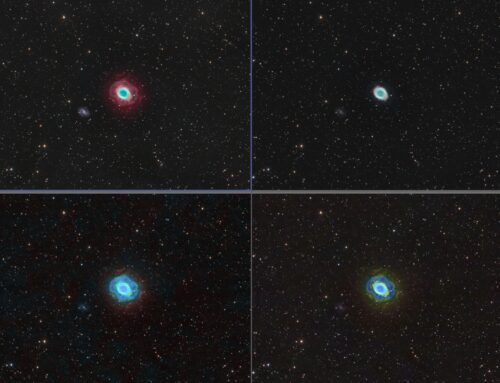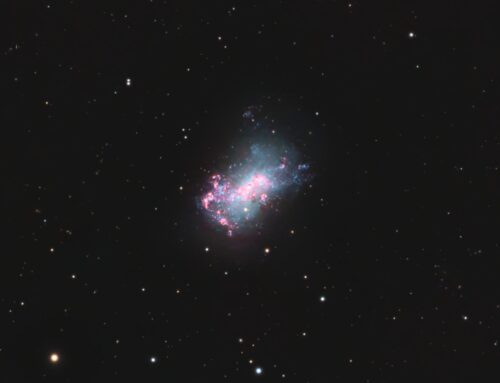NGC 281, The Pacman Nebula Hubble Palette Natural Colour
Hubble Palette Natural Colour
Click links for full size versions
February 1, 2021
NGC 281 is known as the Pacman Nebula. This nickname comes from its appearance, resembling an early video game character. Open cluster IC 1590 lies near the centre of the nebula. These cluster stars were born out of the Pacman’s hydrogen, and now cause it to glow. Oxygen and sulfur also contribute, but their influence is hard to see in the natural colour version (at right). The black, dense globules within the nebula are called Bok globules, from which the bright stars are born. The Pacman is about 9,500 light years away, and covers a little more sky than the full Moon. I have imaged this object previously (most recently in 2018), but the current version shows significantly more detail, particularly in the narrowband version, including lots of curdling in the centre of the nebula and a ton of structure around the dark gash in the nebula. For you Ha lovers, an Ha only version from 2015 is also available.
The blue-and-gold hued image was taken using narrowband filters that pass only a few wavelengths from sulfur, hydrogen and oxygen, which are mapped to red, green and blue. This false-colour or “tone-mapped” palette is aesthetically pleasing, and reveals structures that broadband natural colour images, like the red-hued image on the right, can’t. Hydrogen and sulfur both emit red light, and can’t be distinguished in the broadband image. I used the star colours from the right hand image to lend a more natural appearance to the stars in the narrowband image.
Tekkies:
Acquisition, focusing, and control of Paramount MX mount, unguided, with TheSkyX. Focus with Optec DirectSync motor and controller. Automation with CCDCommander. Equipment control with PrimaLuce Labs Eagle 3 Pro computer. All pre-processing and processing in PixInsight. Acquired from my SkyShed in Guelph. Average transparency and seeing. Data acquired November 7-10, 2020 in a mostly moonless sky.
Monochrome: Sky-Watcher Esprit 150 f/7 refractor and QHY 16200-A camera with Optolong UV/IR, H-alpha, O(III) and S(II) filters
Chrominance: Takahashi FSQ-106 ED IV @ f/5 and QHY367C Pro one-shot colour camera with Optolong UV/IR filter
HA: 26 x 10m = 4hr20m
O3: 25 x 10m = 4hr10m
S2: 24 x 10m = 4hr00m
Lum: 25 x 10m = 4hr10m (used for natural colour image)
OSC: 105 x 5m = 8hr45m (used for natural colour image)
Total for SHO image: 12hr30m
Total for HaLRGB image : 17hr15m
Data Reduction and Cleanup
The WeightedBatchPreProcessing script was used to perform calibration, cosmetic correction , registration and integration of all frames.
Chrominance
Creation and cleanup: The S2, Ha and O3 were combined to make an RGB image. DynamicBackgroundExtraction and BackgroundNeutralization were applied to the image.
Linear Noise Reduction: MultiscaleLinearTransform was used to reduce noise in the RGB image. Layer settings for threshold and strength: Layer 1: 5.0 0.85 Layer 2: 4, 0.75 Layer 3: 3, 0.64 Layer 4: 2.0, 0.2 Layer 5: 1, 0.1.
Stretching: HistogramTransformation was applied to make a pleasing, bright image, with background set to an intensity of approximately 0.10
Luminance
Creation of Synthetic Luminance: ImageIntegration was used to make a noise-weighted average of the three masters. This was used as synthetic luminance.
Deconvolution: A star mask was made to use as a Local Deringing Support image. A copy of the luminance image was stretched to use as a range mask. Deconvolution was applied (100 iterations, regularized Richardson-Lucy, external PSF made using PSFImage script with 50 stars).
Linear Noise Reduction: MultiscaleLinearTransform was used to reduce noise in the background areas, using an internal mask to protect bright structures. Layer settings for threshold and strength: Layer 1: 4.0 0.9 Layer 2: 3.0, 0.75 Layer 3: 2.0, 0.6 Layer 4: 0.5, 0.2.
Stretching: HistogramTransformation was applied to make a pleasing, bright image, with background set to an intensity of approximately 0.1.
Combining Luminance and Chrominance
LRGB Combination: The synthetic luminance was applied to the chrominance image using LRGBCombine with default settings.
Additional Processing
Nonlinear Noise Reduction: TGVDenoise was used in L*a*b* mode to reduce noise with a mask used to mainly target the background areas and protect the stars (max. 1000 iterations and convergence selected for both luminance and chrominance).
Contrast Enhancement: LocalHistogramEqualization was applied twice using a mask to select the bright parts of the nebula and protect stars and background. The first pass was with a scale of 40 (max contrast 1.5, strength 0.32, 1 iteration), followed by a scale of 150 (max contrast 1.5, strength 0.25, 1 iteration).
Sharpening: MultiscaleLinearTransform was used to sharpen Layers 2 and 3 with strengths of 0.4 and 0.1, respectively. A mask was used to limit sharpening to high-signal areas and to protect the stars and background regions.
Hue Adjustment: The green tones were transformed towards blue, and yellows towards red, using CurvesTransformation’s Hue adjustment. SCNR was applied with a strength of 0.20.
Star Colour Adjustment: The a* and b* channels from the natural-colour RGB image were extracted using ChannelExtraction in L*a*b* mode and used to replace the same channels of the narrowband image using ChannelCombination through a star mask, to impart a more natural colour to the brighter stars.
Final Steps: Background, nebula and star brightness, contrast, saturation and hue were adjusted in several iterations using CurvesTransformation with masks as required. The DarkStructureEnhance script was applied with a strength of 0.15. ICCProfileTransformation (sRGB IEC61966-2.1; Relative Colorimetric with black point compensation) was applied prior to saving as a jpg.






Ron you are awesome thank you for all you do 😜
I really like the detail in the Hubble palette, the dark gash really shows a lot of detail in the Ha version.